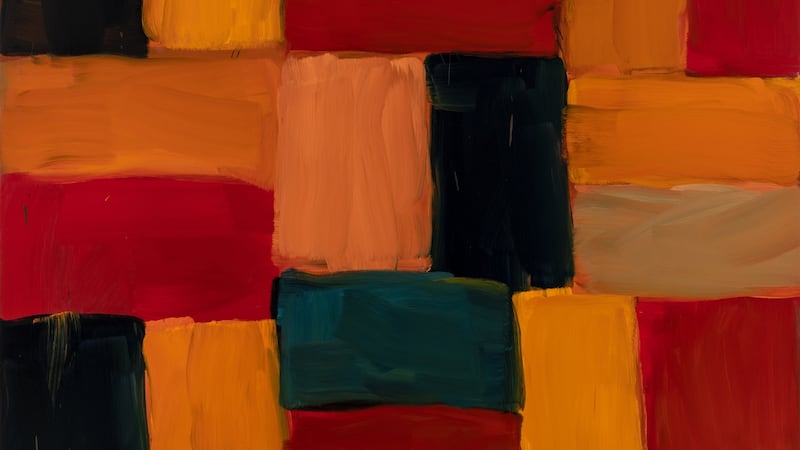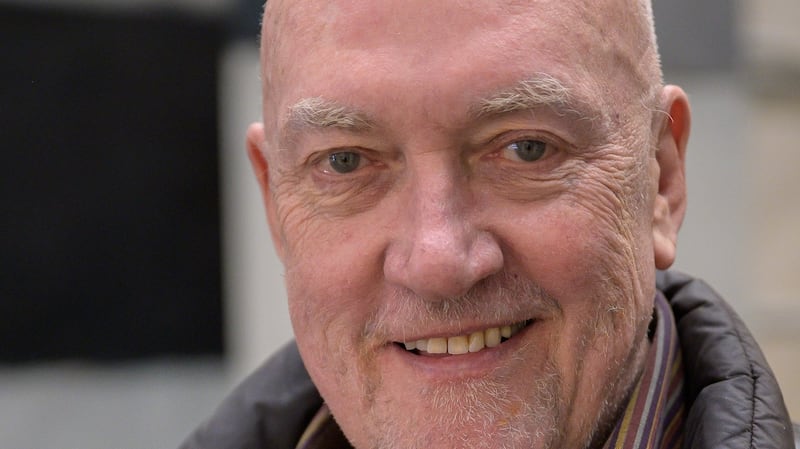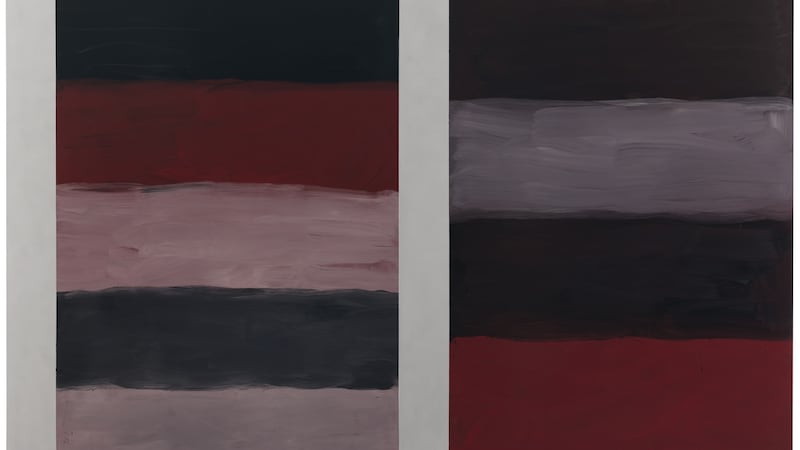Sean Scully's oil painting Landline Rising Blue hangs at the back of the Thaddaeus Ropac gallery, up a few steps where the altar would be if the ultra-modern, white-walled, granite-floored space in the Marais were a church. Sunlight pours in through a skylight. The rich, blue horizontal stripes exude serenity. Visiting Scully's Between Heaven and Earth exhibition is almost a religious experience.
“My paintings are created to make something that is not as troubled as I am. Not as violent as I am, not as opinionated, not as visceral,” Scully says as he guides me through his biggest Paris show in 25 years.
Scully is one of the world’s most famous abstract painters, and doubtless the most successful living Irish artist. His multicoloured paintings of stripes and boxes, and the steel and stone sculptures he creates from similar themes, are instantly recognisable.
Scully is part of what he calls 'the Irish gang' in southern France, which includes Belfast-born property magnate Paddy McKillen and their mutual friend Bono.
Most of the 22 paintings on show in Paris until July 31st are priced between €1 million and €2 million each. Eager to guarantee his own legacy, Scully gives generously to museums, but retains much of his own work to allow him to control supply – and prices.
Scully owns homes in Bavaria, Berlin, London, Munich and New York, and has just acquired a large 19th-century country house outside Aix-en-Provence. Its proximity to Château La Coste, owned by his close friend, the Belfast-born property magnate Paddy McKillen, was a key motivation for the purchase. Scully is part of what he calls "the Irish gang" in southern France, which includes McKillen and their mutual friend Bono.
‘Racist’ America
The election of Donald Trump in 2016 "broke my relationship with America", Scully says. "I'm heartbroken. I can't forgive it." But Trump's re-election bid failed, I note. "I still can't forgive it. He won and the ugly, bigoted, racist underbelly of America now feels entitled. That has influenced my decision to try and educate my son in Europe. "
Scully hopes to settle eventually between his home at Mooseurach, south of Munich, and Aix. He turned 76 on June 30th, and says he intends to live another 20 years, retiring at 95.

Scully relishes telling his own rags-to-riches story, “from the streets of Inchicore to his own private jet . . . from a gypsy campsite to Harvard”. He speaks with a strong working-class London accent – think Michael Caine or Bob Hoskins – and he remains in many ways a scrappy, bragging, swearing, street-fighter, wielding sarcasm like a knife. “I am an Irishman and I love a good fight,” he says. “So the stones that [art critics] threw at me, I said, ‘Okay, motherf*ckers, take some more’.”
Utter self-confidence and sheer force of will enabled him to transform his impoverished childhood and the tragic loss of his son from his first marriage into something positive.
Scully's outbursts alternate with learned perorations about the great painters of history. Glimpses of Scully the softie peek around the rough edges, similar to the way canvas or metal supports can be seen through his painted surfaces. He recounts the stray dogs he rescued in Morocco and the Bahamas, explains his vegetarianism: "Every day six billion animals are killed. I don't want to be a part of that."
Scully is most endearing when he evokes "my lovely wife", the Swiss artist Liliane Tomasko, and their 12-year-old son, Oisín. Utter self-confidence and sheer force of will enabled him to transform his impoverished childhood and the tragic loss of his son from his first marriage into something positive. He describes his life at present as "very sweet".
Luminous brick wall
The Paris exhibition features four main themes of Scully’s art. He has returned to the Wall of Light and Inset motifs repeatedly over three decades. The Landline series is more recent, and he invented the Mirroring series during the Covid-19 pandemic.
In the Wall of Light paintings, Scully applies several layers of oil paint to create what looks like an irregular, multicoloured, luminous brick wall. Bono, who collects Scully’s art, has called him “the bricklayer of the soul”.
Scully successfully transposed the theme to sculpture in Wall of Light Cubed, constructed from pink and grey scored boulders on the grounds of McKillen's Château La Coste. The giant cube conveys monumental permanence, like the neolithic ruins that Scully admires in Ireland.
In recent years, Scully has painted a great deal on copper and aluminium, in part because of a fluke accident. The air conditioning broke down at the Joan Miró Foundation in Barcelona during his 2007 exhibition there. “There was one particular lender who threatened to pull all his paintings out, which would have devastated the exhibition, plus the paintings looked like towels, I must say; distressed.” Metal supports provide the added advantage of giving the paintings a luminous look they would not have on canvas.
The colours in Scully's Walls of Light range from grey – "the colour of memory" – to bright red and orange. By his own admission, his choice of colours is often melancholy. It is perhaps a sign of his happy family life that he used bright yellow prominently in the Wall of Light entitled Star, painted under lockdown this year. "This is an homage to my beloved Van Gogh, who I adore," Scully says. The title refers to Van Gogh's Starry Night.

In his late teens, Scully worked as a labourer on the Victoria Station Ballroom in London. He went to see Van Gogh's Chair at the Tate Millbank every day during his lunch break. "It seemed as if it was something I could do myself," he told the BBC's 2019 documentary, "Unstoppable: Sean Scully and The Art of Everything."
Mountain metaphor
Scully compares his Walls of Light to Cézanne’s paintings of the Montagne Sainte-Victoire, and to Claude Monet’s series of Rouen Cathedral. “The metaphor of the mountain made of monumental boulders is echoed in the walls I paint,” he told the French edition of The Art Newspaper. Monet’s “transformation of a stone edifice into a luminous image, the cancellation of physical weight through painting, I find that very moving.”
Scully compares his incorporation of insets into his paintings to Matisse’s use of windows. During the Covid-19 pandemic, he created a series of works with large, black insets at their centre, an allusion to the Russian avant-garde artist Kazimir Malevitch, and a personal expression of dismay.
“The black square by Malevitch [in 1915] and the urinal by R Mutt [the pseudonym used by Marcel Duchamp in 1917] are the two radical icons at the beginning of the 20th century,” Scully explains. He describes Malevitch’s square as “a cultural fact that somehow flies through the air and gets repositioned in the middle of a painting . . . It’s a portrait of our time.”
Black Window Pale Land, painted last year in Bavaria, combines the horizontal stripes of a Landlines painting with a black insert. It is, Scully admits, barren and austere. “Smack in the middle of it is this nihilistic object that refers of course to the situation we were in, not that we’re in now, but the one we were in, which was no past and a difficult future.”
Scully’s Landlines series grew out of a photograph he took from a clifftop in Norfolk in 1999, showing bands of green grass, blue-green sea and grey sky. He has also likened the Landlines paintings to the view from Galway Bay towards the Aran Islands.

The Landlines are inspired by 19th-century romantic European landscape paintings, Scully says. One could almost transpose the monk in Caspar David Friedrich's Monk by the Sea, one of the most famous paintings in Germany, to the foreground of his own Landline Rising Blue, he says.
There is a further explanation for the Landlines series. In 2014, Scully became addicted to Oxycontin after a back injury. His wife discovered that the drug was a dangerous opioid. Scully stopped taking it, went through cold turkey, and was in such pain that he could only paint horizontal stripes.
‘Mutation and repetition’
Scully’s latest innovation, the series entitled Mirroring, created during the pandemic, is presented for the first time at the Thaddaeus Ropac gallery. The works are comprised of large diptychs, painted on aluminium, in which two Landlines separated by a vertical, aluminium strip seem to reflect each other. “These are meant to be a combination of a number of things like book pages, musical scores, couples that mirror each other but don’t imitate each other exactly,” Scully explains. “I’m playing around with the idea, the mutation and repetition, and of course I’m making references to 19th-century painting.”
Scully has lectured in universities around the world. The Chinese dissident artist Ai Weiwei was one of his students. Nuggets of wisdom, invaluable for any creative undertaking, shine through his bluster and bravado. When I ask if he plans his paintings in advance, he recounts a Monty Python joke about German philosophers playing football. "They were discussing intuition versus logic and meanwhile somebody else kicked the ball." Artists and writers must dispense with the preliminaries and "just do it", Scully says. Nor does he indulge in self-doubt. "It's already difficult enough without you putting roadblocks in your own way," he told the BBC documentary.
You never want to be out of your skin. You want to be in your body, in your work, and your work has to embody your ambition.
Scully’s “beloved Van Gogh” never sold a painting and took his own life. “Van Gogh couldn’t find a girlfriend. That was the real problem,” Scully says. “He couldn’t find love because he wanted it too much. It’s like fishing: when you act too desperately, things go away from you . . . You have to allow something to come to you.”
Is the same true in art?
“Yeah,” Scully replies. “You can’t be grasping. There’s a phrase in America: ‘She’s out of her skin.’ You never want to be out of your skin. You want to be in your body, in your work, and your work has to embody your ambition. You can’t grasp, because that’s ugly, ugly, ugly.”



















